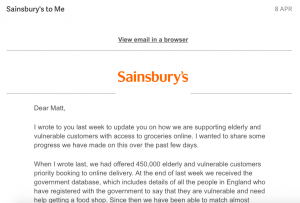Coronavirus has turned our world upside down.
Office workers are all working at home, our movements are restricted and our daily habits and behaviours have transformed.
How is that reflected in our online habits?
Attention
News views are at record level
Unsurprisingly, news sites have experienced a huge surge as we search for the latest coronavirus updates and maybe an elusive sense of security and control.
The Guardian reported a record 2.17 billion page views in March – and 70% of them were to coronavirus stories.
People don’t just want one-off updates – they need to be kept in the know as the situation changes hour by hour, minute by minute.
Sainsbury’s are also sending image-free weekly emails from their Chief Executive, Mike Coupe, updating everyone on what they’re doing in their stores. The emails update recipients on everything the company is doing to tackle the situation, and build brand loyalty as a side effect.

People are watching a lot more YouTube
YouTube February watch time has soared in several of the worst-affected countries
The biggest growth was in Italy, where views grew 20-fold in February 2020. Germany was next, experiencing 11x growth during the same period.
Now might be the time to revisit brand building pre-roll ads.
Interestingly, over 10% of people (from the survey below) also say they are creating and uploading videos.
45% of global consumers are spending more time on social media
In a global survey of over 13,000 consumers in 13 countries in March 2020, GlobalWebIndex found that 45% of respondents are devoting more time to social media.
Not only that, but over 50% are watching more streaming services (Netflix is obviously a big winner here) and 45% are spending more time on messaging services as they seek to connect with friends and family in other households.
Neither stat is massively surprising of course. The fact that we’re spending more time on messaging apps hints at a desire for one-to-one communication and relationship-building, which will apply to supporter relationships with charities too.
Advertising
Charities are advertising in droves
We have so far collected examples of over 60 adverts from charities that we’ve seen in our own feeds.
Many are running emergency coronavirus appeals. Others are clearly doubling down on advertising the kinds of fundraising you can do from home, like lottery and animal sponsoring.


You can find out more about how charities are advertising online in our upcoming webinar with JustGiving.
Images are changing
The choice of images used in online ads has changed since the start of the coronavirus pandemic.
Analysing more than 1,100 brands and advertisers active on Facebook and Instagram, a study by Pattern89 found that there are 27.4% fewer images and videos ads of models displaying human interaction, like hugging or shaking hands.
While your ad images don’t have to all reflect the coronavirus pandemic somehow, images that don’t reflect our massively changed lifestyles or even remind us of what we all want but can’t have, won’t always go down well.
Support
People need more support than ever before
Most worrying of all, we’re seeing that search interest in the services that charities so often provide has grown exponentially.
Searches related to things like therapeutic support, abusive partners (as lockdown means captivity for people with abusive partners) and how to access food banks have all grown.
We’re seeing some service-related searches increase by hundreds and others even thousands of percent on pre-coronavirus levels.
When people search for support, they search very specific terms. They want help that’s tailored to their exact needs.
As always, check your search terms report in Google Ads to see exactly what services your users need.
Fundraising
Donation habits have changed
The volume of donations through standard donate pages on charity websites is down, although emergency appeals may see this change.
This may well reflect the fact that over a million more people are on Universal Credit, and many more being furloughed indefinitely, often on 80% of their usual pay, and so are reviewing their spending. Those that aren’t are going to be distracted at best.
However, the average donation value has actually increased in places.
Charities stand to lose £4 billion in 12 weeks from coronavirus. So while digital can’t be the whole solution to that, it’s definitely true that charities need to be as relevant online as possible to the changing world they exist in to survive.
How coronavirus has changed our online habits
Coronavirus has turned our world upside down.
Office workers are all working at home, our movements are restricted and our daily habits and behaviours have transformed.
How is that reflected in our online habits?
Attention
News views are at record level
Unsurprisingly, news sites have experienced a huge surge as we search for the latest coronavirus updates and maybe an elusive sense of security and control.
The Guardian reported a record 2.17 billion page views in March – and 70% of them were to coronavirus stories.
People don’t just want one-off updates – they need to be kept in the know as the situation changes hour by hour, minute by minute.
Sainsbury’s are also sending image-free weekly emails from their Chief Executive, Mike Coupe, updating everyone on what they’re doing in their stores. The emails update recipients on everything the company is doing to tackle the situation, and build brand loyalty as a side effect.
People are watching a lot more YouTube
YouTube February watch time has soared in several of the worst-affected countries
The biggest growth was in Italy, where views grew 20-fold in February 2020. Germany was next, experiencing 11x growth during the same period.
Now might be the time to revisit brand building pre-roll ads.
Interestingly, over 10% of people (from the survey below) also say they are creating and uploading videos.
45% of global consumers are spending more time on social media
In a global survey of over 13,000 consumers in 13 countries in March 2020, GlobalWebIndex found that 45% of respondents are devoting more time to social media.
Not only that, but over 50% are watching more streaming services (Netflix is obviously a big winner here) and 45% are spending more time on messaging services as they seek to connect with friends and family in other households.
Neither stat is massively surprising of course. The fact that we’re spending more time on messaging apps hints at a desire for one-to-one communication and relationship-building, which will apply to supporter relationships with charities too.
Advertising
Charities are advertising in droves
We have so far collected examples of over 60 adverts from charities that we’ve seen in our own feeds.
Many are running emergency coronavirus appeals. Others are clearly doubling down on advertising the kinds of fundraising you can do from home, like lottery and animal sponsoring.
You can find out more about how charities are advertising online in our upcoming webinar with JustGiving.
Images are changing
The choice of images used in online ads has changed since the start of the coronavirus pandemic.
Analysing more than 1,100 brands and advertisers active on Facebook and Instagram, a study by Pattern89 found that there are 27.4% fewer images and videos ads of models displaying human interaction, like hugging or shaking hands.
While your ad images don’t have to all reflect the coronavirus pandemic somehow, images that don’t reflect our massively changed lifestyles or even remind us of what we all want but can’t have, won’t always go down well.
Support
People need more support than ever before
Most worrying of all, we’re seeing that search interest in the services that charities so often provide has grown exponentially.
Searches related to things like therapeutic support, abusive partners (as lockdown means captivity for people with abusive partners) and how to access food banks have all grown.
We’re seeing some service-related searches increase by hundreds and others even thousands of percent on pre-coronavirus levels.
When people search for support, they search very specific terms. They want help that’s tailored to their exact needs.
As always, check your search terms report in Google Ads to see exactly what services your users need.
Fundraising
Donation habits have changed
The volume of donations through standard donate pages on charity websites is down, although emergency appeals may see this change.
This may well reflect the fact that over a million more people are on Universal Credit, and many more being furloughed indefinitely, often on 80% of their usual pay, and so are reviewing their spending. Those that aren’t are going to be distracted at best.
However, the average donation value has actually increased in places.
Charities stand to lose £4 billion in 12 weeks from coronavirus. So while digital can’t be the whole solution to that, it’s definitely true that charities need to be as relevant online as possible to the changing world they exist in to survive.
Matt Collins
Other posts by this author
Share on social
Matt Collins
Other posts by this author
Share on social
Recent Posts
Getting to grips with AI Max in Google Ads
The Impact of Google’s AI Overviews on charity website traffic – and what to do about it
Charlotte’s Know Your Nodes campaign on ITV’s This Morning
Find out how we can help your cause
If you would like to learn more about how we can help your cause or you have a general query, please get in touch using the contact form below and we will get back to you as soon as possible.